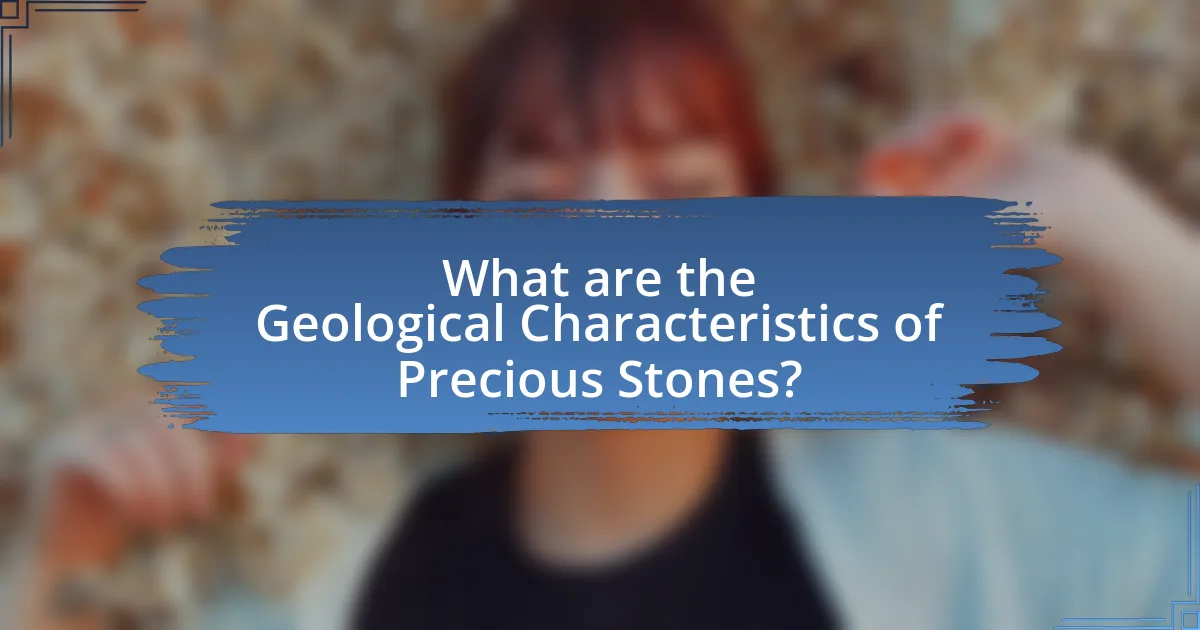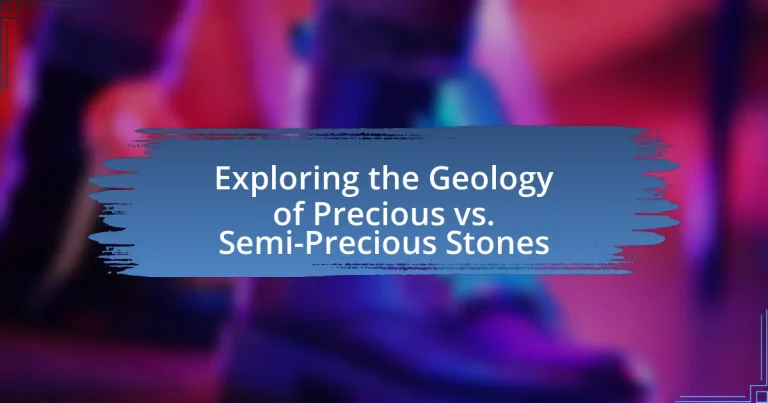The article focuses on the geology of precious and semi-precious stones, defining precious stones as rare and valuable gemstones like diamonds, rubies, sapphires, and emeralds, while semi-precious stones include more abundant varieties such as amethyst and garnet. It explores the classification criteria based on rarity, value, and physical properties, as well as the geological processes that lead to their formation, including crystallization, metamorphism, and sedimentation. Additionally, the article examines how market perceptions influence the classification and value of these stones, the implications for consumer choices, and best practices for their care and maintenance. Key geological characteristics and environmental factors affecting the formation of both categories of stones are also discussed, providing a comprehensive overview of their origins and properties.

What are Precious and Semi-Precious Stones?
Precious stones are rare, valuable gemstones that are typically characterized by their beauty, durability, and rarity, such as diamonds, rubies, sapphires, and emeralds. Semi-precious stones, on the other hand, are more abundant and generally less expensive, including stones like amethyst, garnet, and turquoise. The distinction between precious and semi-precious stones is largely based on historical and market perceptions rather than strict geological criteria, as both categories can be formed from a variety of minerals and geological processes.
How are Precious and Semi-Precious Stones classified?
Precious and semi-precious stones are classified based on their rarity, value, and physical properties. Precious stones, such as diamonds, rubies, sapphires, and emeralds, are considered more valuable due to their rarity and superior qualities, including hardness and brilliance. In contrast, semi-precious stones, like amethyst, garnet, and turquoise, are more abundant and generally less expensive. This classification is supported by historical market trends and gemological standards, which emphasize the significance of rarity and desirability in determining a stone’s classification.
What criteria determine the classification of stones?
The classification of stones is primarily determined by their mineral composition, hardness, luster, and rarity. Mineral composition refers to the specific minerals that make up the stone, which can influence its appearance and properties. Hardness is measured on the Mohs scale, where stones are rated based on their ability to resist scratching; for example, diamonds are classified as precious stones due to their high hardness. Luster describes how light interacts with the surface of the stone, affecting its visual appeal. Rarity plays a crucial role as well; stones that are less commonly found or more difficult to mine are often classified as precious. These criteria are widely accepted in geology and gemology, providing a systematic approach to categorizing stones based on their physical and aesthetic characteristics.
How do market perceptions influence the classification?
Market perceptions significantly influence the classification of stones as precious or semi-precious. This classification is largely driven by consumer demand, cultural significance, and historical context, which shape how different stones are valued in the marketplace. For instance, diamonds, rubies, sapphires, and emeralds are classified as precious due to their rarity and high demand, while stones like amethyst and garnet are considered semi-precious despite their beauty and geological properties. The Gemological Institute of America (GIA) notes that market trends and consumer preferences can shift the perceived value of certain stones, leading to reclassification over time. Thus, market perceptions directly impact the economic categorization of gemstones.
What geological processes lead to the formation of these stones?
The geological processes that lead to the formation of precious and semi-precious stones include crystallization, metamorphism, and sedimentation. Crystallization occurs when minerals solidify from molten rock or mineral-rich solutions, forming gemstones like diamonds and sapphires. Metamorphism involves the alteration of existing rocks under heat and pressure, resulting in stones such as emeralds and garnets. Sedimentation refers to the accumulation of mineral particles over time, which can lead to the formation of stones like opals and agates. These processes are well-documented in geological studies, illustrating how specific environmental conditions and mineral compositions contribute to the diversity of gemstones found in nature.
What role does mineral composition play in stone formation?
Mineral composition is crucial in stone formation as it determines the physical and chemical properties of the resulting stone. Different minerals contribute unique characteristics such as color, hardness, and luster, which define whether a stone is classified as precious or semi-precious. For example, diamonds, composed of carbon in a crystal lattice structure, exhibit exceptional hardness, making them highly valued. In contrast, stones like amethyst, primarily made of silicon dioxide, display distinct colors due to trace elements. The specific arrangement and types of minerals present influence not only the aesthetic qualities but also the durability and applications of the stones in various industries.
How do environmental factors affect the geology of these stones?
Environmental factors significantly influence the geology of precious and semi-precious stones by affecting their formation, composition, and distribution. For instance, temperature, pressure, and the presence of water play crucial roles in the crystallization process of minerals, determining the types of stones that can form in a given environment. Geological processes such as erosion, sedimentation, and tectonic activity further shape the characteristics of these stones, as seen in the formation of diamonds under high-pressure conditions deep within the Earth’s mantle. Additionally, environmental factors like volcanic activity can lead to the creation of gemstones such as opals and garnets, which are formed from the cooling and solidification of magma. These interactions between environmental conditions and geological processes underscore the diverse origins and properties of precious and semi-precious stones.
Why is the distinction between Precious and Semi-Precious Stones important?
The distinction between Precious and Semi-Precious Stones is important because it influences their market value, rarity, and usage in jewelry and industry. Precious stones, such as diamonds, rubies, sapphires, and emeralds, are typically more valuable due to their rarity and superior qualities, including hardness and brilliance. In contrast, semi-precious stones, like amethyst, turquoise, and garnet, are more abundant and generally less expensive. This classification affects consumer perception, investment decisions, and the overall gemstone market, as precious stones often command higher prices and are seen as status symbols. Historical context shows that the classification has evolved, with some stones previously considered semi-precious gaining value and recognition over time, further emphasizing the significance of this distinction in the gemstone industry.
What implications does this distinction have for value and rarity?
The distinction between precious and semi-precious stones significantly impacts their value and rarity, with precious stones generally commanding higher prices due to their limited availability and greater demand. For instance, diamonds, rubies, sapphires, and emeralds are classified as precious stones, often found in fewer locations and requiring more intensive mining processes, which contributes to their scarcity and high market value. In contrast, semi-precious stones like amethyst and garnet are more abundant and widely available, leading to lower prices and less perceived rarity. This classification affects consumer perception and market dynamics, as the rarity of precious stones often drives investment and collection interest, while semi-precious stones are more accessible for general consumers.
How does this classification affect consumer choices?
The classification of stones into precious and semi-precious significantly influences consumer choices by shaping perceptions of value and desirability. Consumers often associate precious stones, such as diamonds and emeralds, with higher quality and status, leading to a willingness to pay premium prices. In contrast, semi-precious stones, like amethyst and garnet, are perceived as more accessible and affordable, which can attract a different segment of buyers. This classification impacts purchasing decisions, as consumers may prioritize precious stones for significant investments or gifts, while opting for semi-precious stones for everyday use or fashion accessories. The distinction is reinforced by marketing strategies that emphasize the rarity and luxury of precious stones, further guiding consumer preferences and spending behavior.

What are the Geological Characteristics of Precious Stones?
Precious stones exhibit distinct geological characteristics that include their mineral composition, formation processes, and crystal structures. These stones, such as diamonds, rubies, and sapphires, are typically formed under high-pressure and high-temperature conditions deep within the Earth’s crust or mantle. For instance, diamonds crystallize from carbon under extreme conditions, while rubies and sapphires are varieties of corundum, formed from aluminum oxide with trace elements that impart color. The geological environments where these stones are found, such as kimberlite pipes for diamonds or metamorphic rocks for rubies and sapphires, further define their characteristics. Additionally, the hardness of precious stones, measured on the Mohs scale, reflects their crystalline structure, with diamonds ranking the highest at 10, indicating exceptional durability.
How do the physical properties of Precious Stones differ from Semi-Precious Stones?
Precious stones typically exhibit superior physical properties compared to semi-precious stones, characterized by higher hardness, greater brilliance, and enhanced clarity. For instance, diamonds, classified as precious stones, have a hardness of 10 on the Mohs scale, while many semi-precious stones, such as amethyst, have a hardness ranging from 7 to 8. Additionally, precious stones often possess a higher refractive index, contributing to their exceptional brilliance and fire, as seen in rubies and sapphires, which have refractive indices of approximately 1.76 to 1.77, compared to semi-precious stones like garnet, which ranges from 1.72 to 1.75. These distinctions in physical properties are fundamental in determining their value and desirability in the gemstone market.
What are the common physical properties of Precious Stones?
Precious stones commonly exhibit several distinct physical properties, including hardness, brilliance, clarity, color, and specific gravity. Hardness, measured on the Mohs scale, indicates a stone’s resistance to scratching; for example, diamonds rank highest at 10. Brilliance refers to the stone’s ability to reflect light, contributing to its visual appeal, while clarity denotes the presence of inclusions or blemishes, affecting overall quality. Color varies widely among precious stones, influencing their value, with some stones like sapphires and emeralds being prized for their vivid hues. Specific gravity measures density, providing insight into the stone’s composition and authenticity. These properties collectively define the quality and desirability of precious stones in the market.
How do these properties influence their use in jewelry and industry?
The properties of precious and semi-precious stones, such as hardness, brilliance, and rarity, significantly influence their use in jewelry and industry. Hardness, measured on the Mohs scale, determines a stone’s durability; for example, diamonds, rated a 10, are ideal for engagement rings due to their scratch resistance. Brilliance, influenced by a stone’s refractive index, enhances aesthetic appeal, making gemstones like sapphires and emeralds desirable in fine jewelry. Rarity affects market value; precious stones like rubies are less abundant, driving higher prices and demand. In industrial applications, diamonds are utilized for cutting and grinding due to their hardness, while other stones may be used for abrasives or decorative elements. These properties collectively dictate the suitability and economic value of stones in both jewelry and industrial contexts.
What are the most notable Precious Stones and their geological origins?
The most notable precious stones include diamonds, rubies, sapphires, and emeralds, each with distinct geological origins. Diamonds form under high-pressure conditions in the Earth’s mantle, primarily in kimberlite pipes, while rubies and sapphires, both varieties of corundum, originate from metamorphic rocks and alluvial deposits, particularly in regions like Myanmar and Sri Lanka. Emeralds, a variety of beryl, are typically found in metamorphic rocks and are primarily sourced from Colombia, Brazil, and Zambia. These geological processes and locations contribute to the unique characteristics and value of each precious stone.
What geological environments are associated with Diamonds?
Diamonds are primarily associated with kimberlite and lamproite pipes, which are volcanic formations that originate deep within the Earth’s mantle. These geological environments are characterized by high-pressure and high-temperature conditions, typically found at depths of 150 to 250 kilometers. The formation of diamonds occurs when carbon undergoes crystallization under these extreme conditions, often facilitated by the presence of specific minerals and fluids. Additionally, diamonds can also be found in alluvial deposits, where they have been transported by erosion from their primary sources to riverbeds and coastal areas.
How do Rubies and Sapphires form in nature?
Rubies and sapphires form in nature through the crystallization of corundum, a mineral composed primarily of aluminum oxide. This process occurs under high-temperature and high-pressure conditions, typically within metamorphic rocks or igneous environments. The presence of trace elements, such as chromium for rubies and iron or titanium for sapphires, imparts their distinct colors. Geological processes, including volcanic activity and metamorphism, contribute to the formation and concentration of these gemstones in specific locations, such as riverbeds or alluvial deposits.

What are the Geological Characteristics of Semi-Precious Stones?
Semi-precious stones are characterized by their mineral composition, formation processes, and physical properties. These stones typically consist of a variety of minerals, such as quartz, garnet, and tourmaline, which contribute to their unique colors and patterns. The geological formation of semi-precious stones often occurs through processes like crystallization from magma, metamorphism, or sedimentation, resulting in diverse textures and structures. For instance, amethyst, a type of quartz, forms in volcanic rocks, while jadeite, a form of jade, originates from metamorphic processes. The hardness of semi-precious stones, measured on the Mohs scale, generally ranges from 5 to 7, indicating their durability and suitability for various applications, including jewelry.
How do Semi-Precious Stones form and what are their key characteristics?
Semi-precious stones form through various geological processes, including crystallization from molten rock, sedimentation, and metamorphism. These processes occur over millions of years, resulting in the formation of minerals that are classified as semi-precious based on their rarity and value compared to precious stones. Key characteristics of semi-precious stones include their diverse colors, patterns, and hardness, which can vary significantly depending on their mineral composition. For example, amethyst, a type of quartz, exhibits a purple hue due to iron impurities, while turquoise is valued for its unique blue-green color and is formed from the alteration of copper minerals.
What are the common geological formations associated with Semi-Precious Stones?
Common geological formations associated with semi-precious stones include igneous, metamorphic, and sedimentary rocks. Igneous formations, such as basalt and granite, often host stones like amethyst and citrine. Metamorphic rocks, including schist and gneiss, can contain stones like garnet and jade. Sedimentary formations, such as limestone and sandstone, are known for stones like opal and turquoise. These associations are based on the conditions under which the stones form, including temperature, pressure, and mineral composition, which are well-documented in geological studies.
How do the properties of Semi-Precious Stones compare to Precious Stones?
Semi-precious stones generally possess lower hardness, rarity, and market value compared to precious stones. Precious stones, such as diamonds, rubies, sapphires, and emeralds, are characterized by their exceptional hardness (often rated 7 or higher on the Mohs scale), rarity, and high demand, which significantly increases their market value. In contrast, semi-precious stones, including amethyst, turquoise, and garnet, typically have a hardness rating below 7, are more abundant, and are less sought after in the luxury market, resulting in lower prices. For instance, diamonds can reach prices of thousands per carat, while semi-precious stones often range from a few dollars to a few hundred dollars per carat, reflecting their comparative properties and market dynamics.
What are some examples of popular Semi-Precious Stones and their origins?
Some examples of popular semi-precious stones include amethyst, which originates from Brazil and Uruguay; turquoise, primarily found in the southwestern United States and Iran; and garnet, commonly sourced from India and Madagascar. Amethyst is a purple variety of quartz, valued for its color and clarity, while turquoise is known for its distinctive blue-green hue and has been used in jewelry for thousands of years. Garnet, available in various colors, is often used in both jewelry and industrial applications. These stones are classified as semi-precious due to their relative abundance compared to precious stones like diamonds and emeralds.
What geological processes lead to the formation of Amethyst?
Amethyst forms primarily through the process of hydrothermal mineralization, where silica-rich fluids containing iron and aluminum circulate through volcanic rocks. These fluids cool and crystallize in cavities, leading to the formation of amethyst crystals. The presence of iron ions within the quartz structure is responsible for the characteristic purple color of amethyst, as it absorbs specific wavelengths of light. Geological evidence shows that amethyst deposits are often found in volcanic regions, such as Brazil and Uruguay, where the right conditions for hydrothermal activity exist.
How does the geology of Turquoise differ from that of other Semi-Precious Stones?
Turquoise is a hydrous phosphate of copper and aluminum, which distinguishes its geological composition from other semi-precious stones that may consist of silicates, carbonates, or oxides. The formation of turquoise typically occurs in arid environments where copper-rich solutions interact with aluminum-bearing minerals, leading to its unique blue-green color and porous structure. In contrast, many other semi-precious stones, such as amethyst or garnet, are formed through different geological processes, including volcanic activity or metamorphism, which do not involve the same hydrous phosphate chemistry. This specific mineralogical composition and formation process of turquoise is supported by its occurrence in sedimentary deposits, particularly in regions like the Southwestern United States, where it is often found in association with copper mines.
How can one identify and differentiate between Precious and Semi-Precious Stones?
Precious stones are identified by their rarity, beauty, and durability, while semi-precious stones are more abundant and generally less valuable. Precious stones, such as diamonds, rubies, sapphires, and emeralds, are characterized by their high market value and are often used in fine jewelry. In contrast, semi-precious stones, including amethyst, garnet, and turquoise, are more accessible and typically used in costume jewelry or decorative items. The differentiation can also be based on factors like hardness, clarity, and color saturation, with precious stones usually exhibiting superior qualities in these aspects. Historical classifications have established these distinctions, with precious stones being recognized for their investment value and cultural significance throughout history.
What tools and techniques are used for identification?
Tools and techniques used for identification of precious and semi-precious stones include visual inspection, refractometry, spectroscopy, and hardness testing. Visual inspection allows gemologists to assess color, clarity, and cut, while refractometry measures the refractive index to differentiate between stones. Spectroscopy analyzes light absorption and emission to identify specific minerals, and hardness testing, often using the Mohs scale, determines a stone’s resistance to scratching, aiding in classification. These methods are widely accepted in gemology, ensuring accurate identification based on established scientific principles.
How can consumers ensure they are purchasing genuine stones?
Consumers can ensure they are purchasing genuine stones by seeking certification from reputable gemological laboratories. These laboratories, such as the Gemological Institute of America (GIA) and the International Gemological Institute (IGI), provide detailed reports that verify the authenticity and quality of gemstones. Additionally, consumers should purchase from established jewelers who offer transparency regarding their sourcing and provide information about the stone’s origin. This approach is supported by the fact that certified stones typically come with a grading report that includes specific details about the stone’s characteristics, ensuring buyers receive genuine products.
What are the best practices for caring for Precious and Semi-Precious Stones?
The best practices for caring for precious and semi-precious stones include regular cleaning, proper storage, and avoiding exposure to harsh chemicals. Regular cleaning with a soft cloth and mild soap helps maintain their luster and removes dirt. Proper storage in a soft pouch or a separate compartment prevents scratches and damage from other jewelry. Additionally, avoiding exposure to harsh chemicals, such as bleach or ammonia, protects the integrity of the stones, as these substances can cause discoloration or deterioration. Following these practices ensures the longevity and beauty of both precious and semi-precious stones.
How should different types of stones be cleaned and maintained?
Different types of stones should be cleaned and maintained according to their specific properties. For example, porous stones like limestone and sandstone require gentle cleaning with a soft brush and mild soap to avoid damage, while harder stones such as granite can be cleaned with a mixture of water and vinegar or a pH-balanced cleaner. Additionally, softer stones like marble should be maintained by avoiding acidic cleaners and using a specialized stone cleaner to prevent etching. Regular sealing of porous stones is essential to protect them from stains and moisture, while polishing harder stones can enhance their shine and longevity.
What storage methods help preserve the quality of these stones?
To preserve the quality of precious and semi-precious stones, proper storage methods include using soft cloth pouches, individual compartments in jewelry boxes, and controlled environments with stable temperature and humidity. Soft cloth pouches prevent scratches, while individual compartments avoid contact that can lead to damage. Maintaining a stable environment is crucial, as fluctuations in temperature and humidity can cause stones to crack or lose luster. These methods are supported by gemological practices that emphasize the importance of protecting stones from physical and environmental stressors to maintain their integrity and appearance.


